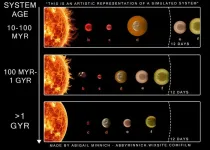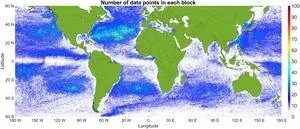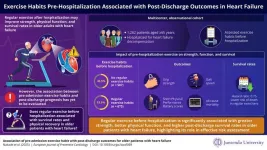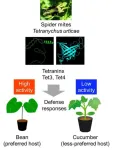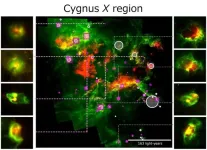(Press-News.org) UNIVERSITY PARK, Pa. — A combination of cosmic processes shapes the formation of one of the most common types of planets outside of our solar system, according to a new study led by researchers at Penn State. The research team used data from NASA’s Transiting Exoplanet Survey Satellite (TESS) to study young sub-Neptunes — planets bigger than Earth but smaller than Neptune — that orbit close to their stars. The work provides insights into how these planets might migrate inward or lose their atmosphere during their early stages.
A paper describing the research appeared today March 17 in the Astronomical Journal. The findings offer clues about the properties of sub-Neptunes and help address long-standing questions about their origins, the team said.
“The majority of the 5,500 or so exoplanets discovered to date have a very close orbit to their stars, closer than Mercury to our sun, which we call ‘close-in’ planets,” said Rachel Fernandes, President’s Postdoctoral Fellow in the Department of Astronomy and Astrophysics at Penn State and leader of the research team. “Many of these are gaseous sub-Neptunes, a type of planet absent from our own solar system. While our gas giants, like Jupiter and Saturn, formed farther from the sun, it’s unclear how so many close-in sub-Neptunes managed to survive near their stars, where they are bombarded by intense stellar radiation.”
To better understand how sub-Neptunes form and evolve, the researchers turned to planets around young stars, which only recently became observable thanks to TESS.
“Comparing the frequency of exoplanets of certain sizes around stars of different ages can tell us a lot about the processes that shape planet formation,” Fernandes said. “If planets commonly form at specific sizes and locations, we should see a similar frequency of those sizes across different ages. If we don’t, it suggests that certain processes are changing these planets over time.”
Observing planets around young stars, however, has traditionally been difficult. Young stars emit bursts of intense radiation, rotate quickly and are highly active, creating high levels of “noise” that make it challenging to observe planets around them.
“Young stars in their first billion years of life throw tantrums, emitting a ton of radiation,” Fernandes explained. “These stellar tantrums cause a lot of noise in the data, so we spent the last six years developing a computational tool called Pterodactyls to see through that noise and actually detect young planets in TESS data.”
The research team used Pterodactyls to evaluate TESS data and identify planets with orbital periods of 12 days or less — for reference, much less than Mercury’s 88-day orbit —with the goal of examining the planet sizes, as well as how the planets were shaped by the radiation from their host stars. Because the team’s survey window was 27 days, this allowed them to see two full orbits from potential planets. They focused on planets between a radius of 1.8 and 10 times the size of Earth, allowing the team to see if the frequency of sub-Neptunes is similar or different in young systems versus older systems previously observed with TESS and NASA’s retired Kepler Space Telescope.
The researchers found that the frequency of close-in sub-Neptunes changes over time, with fewer sub-Neptunes around stars between 10 and 100 million years of age compared to those between 100 million and 1 billion years of age. However, the frequency of close-in sub-Neptunes is much less in older, more stable systems.
“We believe a variety of processes are shaping the patterns we see in close-in stars of this size,” Fernandes said. “It’s possible that many sub-Neptunes originally formed further away from their stars and slowly migrated inward over time, so we see more of them at this orbital period in the intermediate age. In later years, it’s possible that planets are more commonly shrinking when radiation from the star essentially blows away its atmosphere, a process called atmospheric mass loss that could explain the lower frequency of sub-Neptunes. But it’s likely a combination of cosmic processes shaping these patterns over time rather than one dominant force.”
The researchers said they would like to expand their observation window with TESS to observe planets with longer orbital periods. Future missions like the European Space Agency’s PLATO may also allow the research team to observe planets of smaller sizes, similar to that of Mercury, Venus, Earth and Mars. Expanding their analysis to smaller and more distant planets could help the researchers refine their tool and provide additional information about how and where planets form.
Additionally, NASA’s James Webb Space Telescope could permit the characterization of the density and composition of individual planets, which Fernandes said could give additional hints to where they formed.
“Combining studies of individual planets with the population studies like we conducted here would give us a much better picture of planet formation around young stars,” Fernandes said. “The more solar systems and planets we discover, the more we realize that our solar system isn’t really the template; it’s an exception. Future missions might enable us to find smaller planets around young stars and give us a better picture of how planetary systems form and evolve with time, helping us better understand how our solar system, as we know it today, came to be.”
In addition to Fernandes, the research team at Penn State includes Rebekah Dawson, Shaffer Career Development Professor in Science and professor of astronomy and astrophysics at the time of the research and now a physical scientist at NASA. The research team also includes Galen J. Bergsten, Ilaria Pascucci, Kevin K. Hardegree-Ullman, Tommi T. Koskinen and Katia Cunha at the University of Arizona; Gijs Mulders at Pontifical Catholic University of Chile; Steven Giacalone, Eric Mamajek, Kyle Pearson, David Ciardi, Preethi Karpoor, Jessie Christiansen and Jon Zink at the California Institute of Technology; James Rogers at the University of Cambridge, Los Angeles; Akash Gupta at Princeton University; Kiersten Boley at the Carnegie Institution for Science; Jason Curtis at Columbia University; Sabina Sagynbayeva at Stony Brook University; Sakhee Bhure at the University of Southern Queensland in Australia; and Gregory Feiden at the University of North Georgia.
Funding from NASA, including through support of the “Alien Earths” grant; Chile’s National Fund for Scientific and Technological Development; and the U.S. National Science Foundation supported this research. Additional support was provided by the Penn State Center for Exoplanets and Habitable Worlds and the Penn State Extraterrestrial Intelligence Center. Computations for this research were performed with Penn State’s University’s Institute for Computational and Data Sciences’ Roar supercomputer.
END
Combination of cosmic processes shapes the size and location of sub-Neptunes
Newly developed tool helps parse data and detect planets smaller than Neptune around young stars, providing insight into their formation
2025-03-17
ELSE PRESS RELEASES FROM THIS DATE:
New study shows regular exercise pre-hospitalization is linked to better outcomes in heart failure
2025-03-17
Heart failure is a major health concern, especially for ageing populations—it significantly increases mortality rates, and severely impacts quality of life for those affected. Exercise therapy has been shown to be particularly effective for patients with heart failure. Previous research, however, has mainly examined the benefits of exercise after a diagnosis of heart failure. There is a considerable gap when it comes to our understanding of the role that exercise plays before a patient with heart failure is hospitalized.
Now, in a recent study published in the European Journal of Preventive Cardiology on 19 February 2025, researchers from Japan have explored the link between ...
New discovery in plant–pest warfare could lead to sustainable farming solutions
2025-03-17
As global food demand continues to increase, effective pest control remains one of agriculture’s most pressing challenges. Worldwide, farmers apply nearly 4 million tons of chemical pesticides annually to protect their crops, representing a $60 billion industry. While these compounds have significantly boosted agricultural productivity, their widespread use has raised concerns regarding environmental impact, health risks, and the long-term sustainability of modern farming.
The two-spotted spider mite, Tetranychus urticae, exemplifies the limitations of conventional pesticide-based pest management in agriculture and horticulture. ...
Make Indian sign language an official language and open more schools for deaf and hard-of-hearing students, Cambridge study advises Indian government
2025-03-17
University of Cambridge media release
Make Indian Sign Language an official language and open more schools for deaf and hard-of-hearing students, Cambridge study advises Indian Government
UNDER STRICT EMBARGO UNTIL 15:30 INDIA STANDARD TIME / 10:00 UK TIME / 06:00 US ET ON MONDAY 17TH MARCH 2025
Around one in five (over 19%) of India’s deaf and hard-of-hearing children were out-of-school in 2014, according to a survey conducted for the Indian Government.* A new study calls on the Government to address this ongoing educational crisis by recognising ...
Deep dive into space turns up new Spitzer bubbles
2025-03-17
To learn more about the deepest reaches of our own galaxy and the mysteries of star formation, Japanese researchers have created a deep learning model. The Osaka Metropolitan University-led team used artificial intelligence to pore through the vast amounts of data being acquired from space telescopes, finding bubble-like structures that had not been included in existing astronomical databases.
The Milky Way galaxy we live in, like other galaxies in the universe, has bubble-like structures formed mainly during the birth and activity of high-mass stars. These so-called Spitzer bubbles hold important clues to understanding the process of star formation and galaxy evolution.
Graduate School of ...
Attention can be used to drive cooperation – new study
2025-03-17
Our ability to cooperate with others may be influenced by how our attention is captured and directed, as much as by how altruistic we are feeling.
According to a new study by researchers at the University of Birmingham jointly with the University of Zurich, choices made for individual reward or cooperatively for a joint reward can be influenced by presenting information to participants in configurations that naturally draw their attention. The results are published today in Communications Psychology.
Cooperation – defined as the ability of individuals to incur a personal cost for the benefit ...
A post-treatment blood test could inform future cancer therapy decisions
2025-03-17
In the continuing evolution of personalized medicine, a new Yale study has found evidence to support the value of a tool that measures the presence of cancer-derived molecules in the blood of patients with lung cancer years after their treatment.
This tool is a type of molecular residual disease (MRD)detector, which is used after patients have completed their primary treatment in order to monitor their cancer status. Researchers say it could inform clinical intervention, including whether to restart or intensify treatment.
“MRD detection is the future — allowing ...
Bridging Nature and Nurture: Study reveals brain's flexible foundation from birth
2025-03-17
Riddle me this: how can it be that reading these words activates nearly identical word-sensitive patches of the brain’s visual system in you and nearly every other reader of this story? And that a different set of face-sensitive visual regions—again in almost identical positions in each reader’s brain—would activate to process the faces of the researchers, should you meet them?
For years, researchers have debated how our brains consistently develop areas specialized for recognizing faces, objects, words, and places, despite individuals having vastly different life experiences.
Two competing theories have dominated this discussion. One ...
Newborns with heart defects may face a higher risk of developing childhood cancer
2025-03-17
Research Highlights:
Newborns with congenital heart defects may have a higher risk of developing childhood cancer compared to children born without a heart abnormality.
Congenital heart defects in newborns may also signal an elevated cancer risk for their mothers.
Researchers suggest a multidisciplinary team of health care professionals to care for newborns with congenital heart defects and their moms.
Embargoed until 4 a.m. CT/5 a.m. ET Monday, March 17, 2025
DALLAS, March 17, 2025 — Being born with a heart defect may ...
Continued medication important for heart failure patients
2025-03-17
Patients who have been treated for heart failure and experience an improvement of their pump function, are still at higher risk of heart-related death or hospitalisation if they stop taking heart failure medications. This is according to a new study from Karolinska Institutet published in the top-ranked journal Circulation.
“Our finding raises awareness about the importance of implementing and not withdrawing medical treatments in daily clinical practice even if patients with heart failure experience an improvement in symptoms and pump function,” says the study’s last author Gianluigi Savarese, docent and senior ...
Tools to succeed: Learning support for new nurses
2025-03-17
First-year nurses often have difficulties while bridging the gap between educational theory and required workplace practice. In the fast-paced medical field, sufficient guidance is hard to come by, so new nurses must actively learn on their feet through modeling senior nurses’ actions and techniques. There are several studies on learning from role models, but no specific tools that focus on new nurses’ learning progress through this practice.
A new tool, called the Modeling Scale for Novice Nurses, has been developed by Dr. Yayoi Nagano and Professor Yasuko Hosoda at Osaka Metropolitan University’s Graduate School of Nursing. They conducted a questionnaire on ...
LAST 30 PRESS RELEASES:
When is it time to jump? The boiling frog problem of AI use in physics education
Twitter data reveals partisan divide in understanding why pollen season's getting worse
AI is quick but risky for updating old software
Revolutionizing biosecurity: new multi-omics framework to transform invasive species management
From ancient herb to modern medicine: new review unveils the multi-targeted healing potential of Borago officinalis
Building a global scientific community: Biological Diversity Journal announces dual recruitment of Editorial Board and Youth Editorial Board members
Microbes that break down antibiotics help protect ecosystems under drug pollution
Smart biochar that remembers pollutants offers a new way to clean water and recycle biomass
Rice genes matter more than domestication in shaping plant microbiomes
Ticking time bomb: Some farmers report as many as 70 tick encounters over a 6-month period
Turning garden and crop waste into plastics
Scientists discover ‘platypus galaxies’ in the early universe
Seeing thyroid cancer in a new light: when AI meets label-free imaging in the operating room
Neutrophil-to-lymphocyte ratio may aid risk stratification in depressive disorder
2026 Seismological Society of America Annual Meeting
AI-powered ECG analysis offers promising path for early detection of chronic obstructive pulmonary disease, says Mount Sinai researchers
GIMM uncovers flaws in lab-grown heart cells and paves the way for improved treatments
Cracking the evolutionary code of sleep
Medications could help the aging brain cope with surgery, memory impairment
Back pain linked to worse sleep years later in men over 65, according to study
CDC urges ‘shared decision-making’ on some childhood vaccines; many unclear about what that means
New research finds that an ‘equal treatment’ approach to economic opportunity advertising can backfire
Researchers create shape-shifting, self-navigating microparticles
Science army mobilizes to map US soil microbiome
Researchers develop new tools to turn grain crops into biosensors
Do supervised consumption sites bring increased crime? Study suggests that’s a myth
New mass spec innovation could transform research
Maternal nativity, race, and ethnicity and infant mortality in the US
Migration-related trauma among asylum seekers exposed to the migrant protection protocols
Jupiter’s moon Europa has a seafloor that may be quiet and lifeless
[Press-News.org] Combination of cosmic processes shapes the size and location of sub-NeptunesNewly developed tool helps parse data and detect planets smaller than Neptune around young stars, providing insight into their formation
